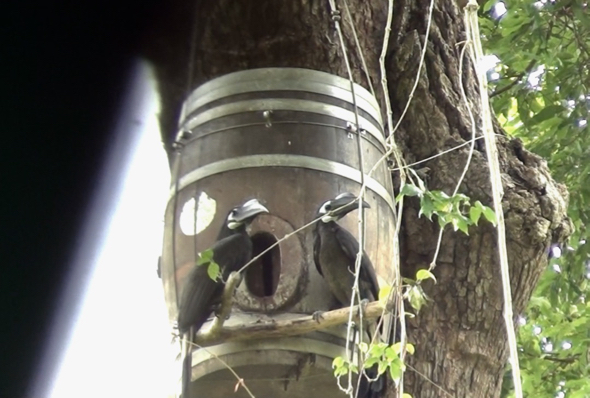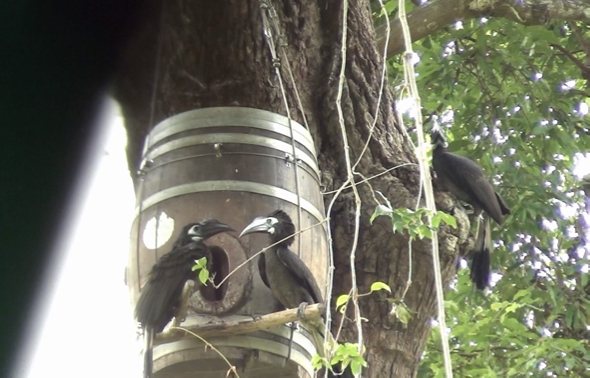“As part of the International Hornbill Research Training Program, participants had the opportunity to visit Budo Mountain for field work. I was able to visit the Bushy-crested Hornbill’s (Anorrhinus galeritus) nest on 9th May 2018 with the trainees and staff of Thailand Hornbill Project (THP).

“Budo Mountain is a part of Budo Su-ngai Padi National Park and it is situated in southern Thailand covering an area of 189km2. The area is largely tropical rainforest but suffers encroachment by illegal loggers and conversion to fruit and rubber plantations. About 40% of the remaining forest supports 6 species of hornbills.
“Since 2004, THP has installed artificial nest boxes in Budo NP to help increase the nest success of these hornbills. To date, 39 chicks have fledged mainly of Great Hornbill. In 2016, THP collaborated with Siam Winery and have been able to install 2 old wine barrel as nest boxes for the hornbills. Bushy-crested Hornbill has started using the wine barrel this year. The wine barrel is installed on a Shorea faguetiana tree (video below).
“The diet of this species is mainly fruits, especially lipid-rich varieties such as Aglaia spectabilis, Dysoxylum spp. (Meliaceae) recorded from southern Thailand. About 30 types of fruits have been identified and only about 10% of the diet is figs. It takes animal food regularly, searching through the forest canopy and probing the bark to find cicadas, other invertebrates, lizards and frogs. Members in the group may collaborate to hunt prey or to chase competitors such as other hornbills, out of fruiting trees.

“In southern Thailand, female seals its nest in March in a cavity and 1-3 chicks fledge in June. This species employs co-operative breeding during nesting; the dominant pair will breed and the other 1-5 birds in the group help out (above). The incubation period is about 30 days; the female will moult her flight feathers while incarcerated. The female and the chicks are fed by the other group members, mainly males, which regurgitate food at the nest.
“We observed this nest from a hide (made of palm leaves) about 50m from the nest.
“Observation time between 8am to 2pm and during that period we recorded the male and helpers (2 males and 2 females) visiting the nest on 11 occassions to feed the female and chicks. Most of the times fruits were given but there were occasional lizards and insects.
“In 1993, Dr. Pilai Poonswad visited southern Thailand as she was concerned that people there were selling chicks of hornbills. She went to all the villages and managed to convince some of them to help to collect data about the breeding and feeding behaviour of the hornbills at the nests. The villagers also help to install artificial nest boxes and the wine barrel next boxes. They are paid on a daily basis depending on the number of days that they work. They need extra work like working in a rubber plantation, fruit orchard or farming to supplement their income.
“You can support the work of THP in southern Thailand by adopting a species of hornbill in southern Thailand for the villagers to safeguard the nest, monitor and collect food and feeding data LINK.
“I would like to thank Mr. Gan Cheong Weei for the long-term loan of Sony HDR-CX150 Handycam to capture this video. Thanks also to Dr. Pilai Poonswad and staff of Thailand Hornbill Project especially Mr. Preeda Thiensongrusamee, Ms. Nureehan Da-ouli and the villagers assisting in hornbill research work at Budo Su-ngai Padi National Park
Bee Choo Strange
Singapore
17th May 2018
Reference:
Poonswad, P., A.C. Kemp & M. Strange. 2013. Hornbills of the World. Draco Publishing and Hornbill Research Foundation. 212 pp.








